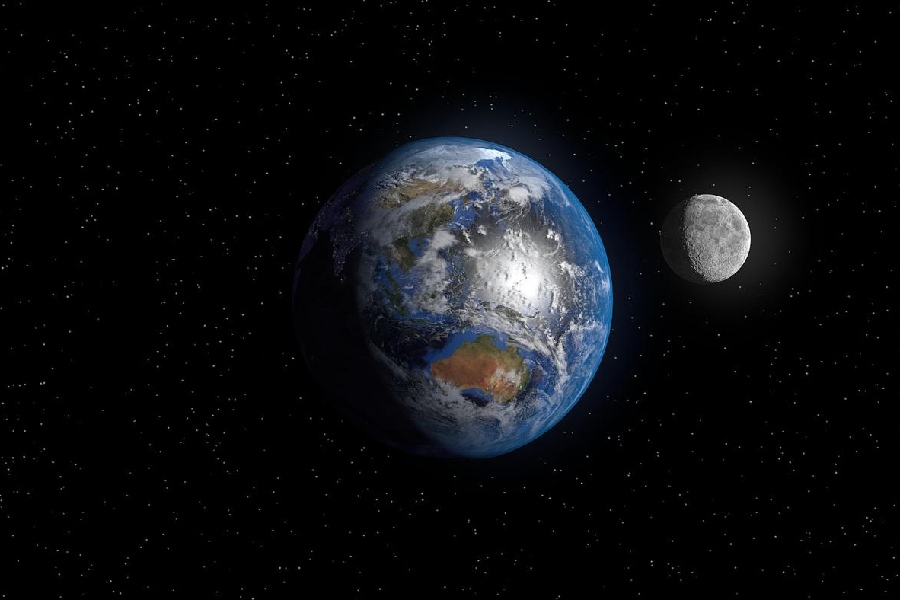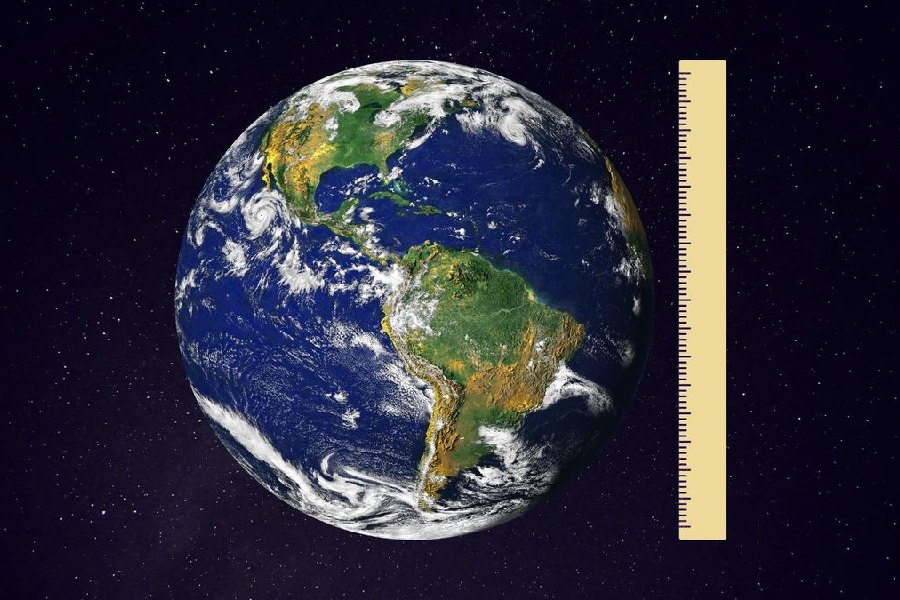The surface of Earth seems endless to us, specifically due to its roundness. The Earth seems enormous, extending endlessly to the horizon. But if you could view our home planet from space, you’d realize the Earth occupies a relatively tiny portion of the vast cosmos. So, just how big is the Earth, the terrestrial globe humanity calls home?
Getting an accurate measurement of Earth’s size may seem straightforward, but it involves some scientific subtleties. To calculate something as large as a planet, should we talk about its diameter, circumference, surface area, or total volume?
As we’ll discuss, each dimensional analysis provides a different piece of the puzzle regarding how immense our global habitat truly is. In this article, we’ll explore the different methods scientists use to measure Earth’s size.
We’ll focus on both local and cosmic scales to understand Earth’s proportions accurately. From exploring rare deviations in Earth’s roundness to how our modest orb stacks up against the staggering sizes of stars and supergiant planets, we’ll discover exactly how big the Earth is.

How Big Is the Earth?
The Earth boasts a diameter of approximately 12,742 kilometers (7,918 miles) at the equator, signifying its considerable size. Scientists employ diverse methods, including satellite technology and mathematical formulas, to quantify its dimensions accurately.
Understanding the Earth’s magnitude aids in scientific research and enhances our appreciation of our home planet’s unique characteristics. Keep reading to discover how big is the Earth in square miles and other measurements related to its size.
Scale of the Earth
Equatorial radius
The equatorial radius measures the distance from the center of Earth to a point located on the equator. The equator is an imaginary line circling around Earth’s widest point. Earth bulges slightly at the equator due to its rotation; this causes the equatorial radius to be greater than measurements taken through the poles.
The average equatorial radius of Earth is 6,378.1 kilometers. To visualize this, picture a line segment extending from Earth’s inner core straight upward to the equatorial surface. That line would measure 6,378.1 kilometers long.
The equatorial bulge results in an equator that lies about 21 kilometers farther from the center point than the polar radius. This difference occurs because of centrifugal forces from Earth’s spin affecting the equatorial zone to a greater degree.
Significance and importance of the mean radius
While Earth has an equatorial bulge, its average radius averages out the planet’s slight irregularities. Factoring together varied measurements from the poles, equator, and all points in between, Earth’s mean radius works out to 6,371 kilometers.
So, if you could run a straight tape measure on average from any spot on Earth through the core out the other side, you’d get a measurement representing a central value of around 6,371 kilometers. This average helps put the planet’s roundness in a numerical context. The equatorial, average, and polar radii help quantify Earth’s overall rounded shape.
Small variations show that the planet is not a perfect sphere. These measures also provide key reference points for mapping locations across Earth’s surface relative to its interior layers and core.
The radii put tangibly into context Earth’s curvature across the different parallels and meridians—from the peaked mountainous terrain, down through the troposphere and crust, past the mantle, to the hot, dense inner core at the center.
Equatorial Radius
The equatorial radius quantifies Earth’s curvature by measuring the distance from the planet’s core to the equator. At the equator, the radius lines from opposite sides meet to mark Earth’s total width, known as its diameter. The average equatorial radius is 6,378 kilometers.
However, Earth isn’t a perfect geometric sphere, so its exact radius increases slightly at the equator. This equatorial bulge is caused by centrifugal forces from Earth’s daily rotation. Its spin on its axis exerts extra forces at the equator.
This causes the equatorial zone to expand outward slightly more than the polar radii in relation to the core. But these variations are usually only by a few kilometers—tiny fractions of the whole.
The average equatorial radius is 6,378 kilometers, while the polar radius is about 6,357 kilometers. So, Earth’s equatorial bulge leads to a difference of 21 kilometers between polar and equatorial measurements.
The equatorial bulge arises due to geophysical processes powered by Earth’s rotation. Quantifying the precise difference between polar and equatorial radii helps scientists model factors like centrifugal forces affecting the planet over time. Tiny changes also impact gravity measurements.

Diameter of the Earth
Earth’s diameter is defined as the length of a straight line passing through the planet’s center from one point on the surface to another on the opposite side. At the equator, Earth’s diameter measures 12,742 kilometers. This quantifies Earth’s full width.
Comparison with other planets
Among other planets in our solar system, Earth has the fifth largest diameter. Jupiter is the largest at 142,984 km. Saturn comes in second at 120,536 km, followed by Uranus, Neptune, and then Earth. After Earth, Mars has about half our diameter at 6,779 km.
More distant dwarf planets like Pluto are smaller yet, with diameters under 2,400 km. So Earth ranks among mid-size planets diameter-wise. A planet’s diameter correlates with its overall size and mass relative to its neighbors. It also dictates surface gravity and density.
Factoring together all dimensional measures enables a better understanding of a world’s internal structure and composition. For Earth, diameter measurements unveil secrets about the thickness of crust layers, division between mantle and core, distribution of heavier elements, and more based on variations.
Factors that Impact the Size of Earth’s Diameter
Several key factors influence measurements of Earth’s diameter over time. Equatorial bulging due to planetary rotation makes Earth not perfectly spherical, impacting equatorial compared to polar diameter measurements.
Slow motions of tectonic plates gradually shift the positions of continents and oceans, altering surface distribution. Erosion and sediment deposition, as well as cyclic climate changes, also reshape continental margins, ocean basins, and exposed coastal lands over long time periods.
Factoring in effects from centrifugal forces, mass transfer, plate tectonics, erosion patterns, and climate change cycles is important for modeling Earth over time.
Accurately tracking diameter changes requires quantifying these processes across Earth’s dynamic geologic history. This quantification provides insights into subsurface architecture and celestial mechanics from the deep interior to the surface crust.
Volume of the Earth
Unlike linear distance measures like radius and diameter, volume measures the entire three-dimensional space taken up by a spherical object. Earth’s volume encompasses everything from the crust surface all the way down to the planet’s central core.
Since direct volume measurements are impossible for a dynamic planet, scientists do estimates done using detailed gravitational readings from satellites.
By modeling the planet as spherical shells of varying density and rigidity, various inferences can be made about composition. Understanding volume distribution enables a better understanding of the forces from gravitational and rotational dynamics affecting our planet.
Surface Area of the Earth
So, how big is the Earth in square miles? Calculating the size of Earth’s entire surface area provides an interesting picture of just how much of our planet is covered by ocean versus land.
To find the total surface area, we need to use the average radius of Earth – approximately 3,959 miles – and plug it into the standard formula for the surface area of a sphere.
When you perform the calculations, you find that Earth has a total surface area of about 197 million square miles. That’s a massive area, but what may be more surprising is how little of it is actually land.
The total land area of Earth is about 57 million square miles – just 29% of the planet. That means the world’s oceans cover about 140 million square miles, accounting for over 70% of Earth’s surface.
So, while maps may make the land masses appear dominant, the reality is that when you quantify the actual surface size, the vast oceans are far larger in terms of square mileage.
Knowing the exact spherical measurements helps put the proportion of land versus water on our planet into numerical perspective. Just 29% of those nearly 200 million total square miles lie above the oceans.
Mass of the Earth
Mass measures the total quantity of matter contained within a body. Specifically, Earth’s mass quantifies the sum of all atoms that make up our home planet. Everything from the crust’s surface to the dense inner core contributes to the total mass. So, how much does the Earth weigh?
Scientists have calculated Earth’s total mass to be around 5.97 x 1024 kilograms. That number written out is about 5,970,000,000,000,000,000,000,000 kilograms. That is quite a hefty bundle!
If you added together the mass of everything alive on Earth – every person, plant, and animal – it would equal less than a millionth of the planet’s entire mass. But how much does Earth weigh in tons? This value translates to 5842 quintillion tons, giving you a sense of the enormity of our planet in terms of its mass.
Quantifying Earth’s global mass enables the calculation of important planet-wide parameters like average density and surface gravity. Higher precision measurements even reveal distribution inconsistencies reflecting processes within Earth’s interior.
Tiny seasonal fluctuations can signal the dynamics of Earth’s system flows among oceans, atmosphere, groundwater, and polar ice. This ever-changing number yields insights into our world’s profound material influence.
Conclusion
As we have explored the various dimensional perspectives for quantifying Earth’s impressive yet finite size, we hope you have gained a renewed appreciation of the planet’s true magnitude.
Learning just how big is the Earth requires looking beyond simplistic surface measures to factor in the world’s structural depth and dynamism across geological epochs.
Our home may seem expensive when gazing at the horizon. However, it occupies just a tiny sliver in the grander scale of our solar system and universe. This article explores Earth’s structure from its crust to its core.
It illuminates key methods for scientifically evaluating Earth’s global scale, utilizing spheres, lines, and volumes. We hope this multidimensional tour has reinforced the intricate balance of forces keeping our small but special orbital habitat in motion through time and space.
